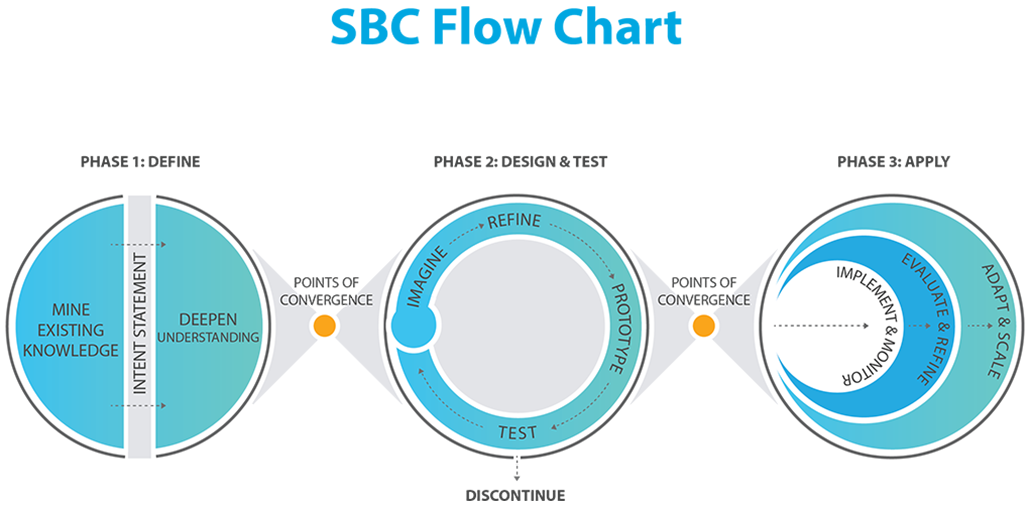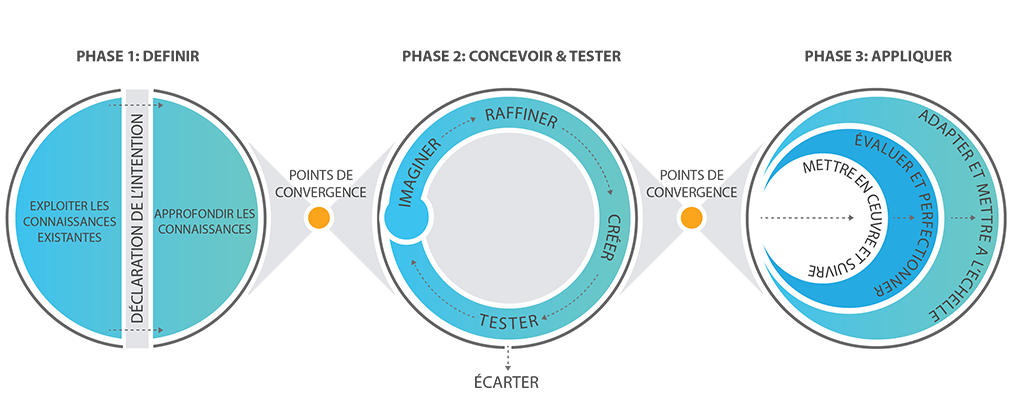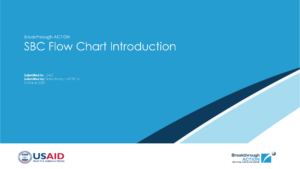Traduction française ci-dessous

The Social and Behavior Change (SBC) Flow Chart is a new process used to develop effective SBC activities. The Flow Chart process actively and meaningfully engages end-users and stakeholders from start to finish, ensuring true co-creation. It harnesses the Breakthrough ACTION consortium partner disciplines (i.e., design, behavioral science, community engagement, market research, and communication) into a new hybrid process that has its roots in the P Process, the human-centered design and behavioral economics design processes, and the Community Action Cycle. The three phases—Define, Design & Test, and Apply—offer project managers a process to more deeply explore and understand context, formulate insights that uncover new truths, build new designs with community members, and test and iterate on locally made designs. Real-time monitoring is the key to ensuring designs are implemented at scale with intended results. Borrowing heavily from human-centered design principles, the SBC Flow Chart requires users to adopt a beginner’s mind to identify new insights to solve sticky public health problems.
The SBC Flow Chart Introduction outlines the disciplines, explains their underpinning methodologies, and explores the tools and techniques that comprise the Flow Chart phases. The country Spotlights showcase how Breakthrough ACTION has used the SBC Flow Chart to address health problems in various countries.
Learn More About SBC
Explore the power of SBC with our toolkit trio:
- Implementing the SBC Flow Chart [Toolkit]
- SBC 101: An Introduction [Course]
- Insights 101 Playbook [PDF]
These tools are crafted to empower SBC practitioners in seamlessly integrating formative research at the define phase to drive informed decisions during the Design & Test and Apply Phases. This guides the creation and implementation of SBC solutions that truly make an impact.
We Want to Hear From You!
The SBC Flow Chart Toolkit and Insights 101 Playbook are exciting additions to Breakthrough ACTION resources. Help shape their excellence by sharing your feedback. Take just 2–3 minutes to complete a short survey after exploring and utilizing these tools.
L’organigramme pour le changement social et de comportement

L’organigramme pour le changement social et de comportement (CSC) est un nouveau processus utilisé pour développer des initiatives efficaces de CSC. Ce processus engage activement et de manière significative les utilisateurs et les intervenants du début à la fin, assurant ainsi une véritable co-création. L’organigramme combine les disciplines des partenaires du consortium Breakthrough ACTION (conception, sciences comportementales, engagement communautaire, études de marché et communication) dans un nouveau processus hybride qui s’inspire du processus P, des processus de conception centrée sur l’humain et d’économie comportementale, ainsi que du cycle d’action communautaire. Les trois phases – Définir, Concevoir et tester, et Appliquer – offrent aux responsables de projet un processus permettant d’explorer et de comprendre le contexte de manière plus approfondie, de formuler des observations qui mettent en lumière des réalités inédites, d’élaborer de nouveaux concepts avec les membres de la communauté, et de tester et d’adapter les concepts élaborés au niveau local. Le suivi en temps réel est essentiel pour s’assurer que les projets sont mis en œuvre à grande échelle avec les résultats escomptés. S’inspirant fortement des principes de la conception centrée sur l’homme, l’organigramme pour le CSC invite les utilisateurs à adopter un état d’esprit de débutant afin d’identifier de nouvelles idées pour résoudre des problèmes complexes de santé publique.
L’introduction de l’organigramme pour le CSC (disponible uniquement en anglais) présente les disciplines, explique les méthodologies fondamentales et explore les outils et les techniques qui composent les phases de l’organigramme. Spotlights des pays (disponible uniquement en anglais) illustrent la manière dont Breakthrough ACTION utilise l’organigramme pour le CSC pour aborder les problèmes de santé dans différents pays.
Pour en savoir plus sur le CSC
Explorez les possibilités du CSC en consultant notre trousse d’outils en trois parties :
- Mettre en oeuvre le diagramme du CSC [Boîte à outils]
- Manuel des découvertes clés 101 [PDF]
Ces outils sont conçus pour permettre aux intervenants du CSC d’intégrer de manière transparente la recherche formative lors de la phase de définition afin de prendre des décisions éclairées lors des phases de conception et de test et d’application. Cela permet de guider la création et la mise en œuvre de solutions de CSC qui ont un impact réel.
Nous aimerions recevoir vos commentaires !
La boite à outils de l’organigramme pour le CSC et le Manuel des découvertes clés 101 sont des ajouts importants parmi les ressources de Breakthrough ACTION. Aidez-nous à définir leur qualité en nous faisant part de votre feedback. Consacrez 2 à 3 minutes pour répondre à un court sondage après avoir exploré et utilisé ces outils.
LEARN MORE
ENGLISH
SBC Flow Chart Introduction [PDF]
Implementing the SBC Flow Chart [Toolkit]
SBC 101: An Introduction [Course]
Insights 101 Playbook [PDF]
EN FRANÇAIS
Mettre en oeuvre le diagramme du CSC [Boîte à outils]
MORE INFORMATION


